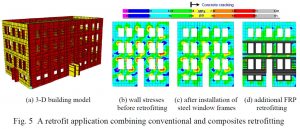Base Isolation
The seismic base isolation technology involves placing flexible isolation systems between the foundation and the superstructure. By means of their flexibility and energy absorption capability, the isolation systems reflect and absorb part of the earthquake input energy before this energy is fully transmitted to the superstructure, reducing the energy dissipation demand on the superstructure. Base isolation causes the natural period of the structure to increase and results in increased displacements across the isolation level and reduced accelerations and displacements in the superstructure during an earthquake. This not only provides safety against collapse, but also largely reduces damage, which is crucial for facilities that should remain operational after severe earthquakes such as emergency response centers, hospitals, and fire stations. Base isolation is generally suitable for low to medium rise buildings, usually up to 10- 12 stories high, which have their fundamental frequencies in the range of expected dominant frequencies of earthquakes. Superstructure characteristics such as height, width, aspect ratio, and stiffness are important in determining the applicability and effectiveness of seismic isolation. The seismicity of the region and the underlying soil conditions should also be considered in the feasibility studies and design process. Base isolation should be avoided in areas where expected fundamental frequencies of the earthquakes are in the lower frequency domain or on soft soil sites where amplification of low earthquake frequencies may occur. One other constraint in the application of base isolation is the large relative displacements between the superstructure and the supporting ground at the isolation level. A clearance around the building must be provided and maintained through the life of the structure to accommodate the expected large displacements. Such displacements may be reduced with the incorporation of additional stiffness and energy dissipation mechanisms in the isolation system.
Seismic isolation is proven to be a very effective method for protecting buildings and other structures against seismic hazards. An important disadvantage of the method, however, is that it cannot be applied partially to structures, unlike most other seismic retrofitting methods. For this reason, the cost of base isolation is often significantly higher than alternative retrofitting methods. This often limits the application of base isolation to
- Special buildings, such as certain industrial, research, public and hospital buildings that contain sensitive equipment or strict operational and performance requirements.
- Historical buildings, the architectural and historic character of which may be harmed by alternative retrofitting methods.
- Bridges, for which relatively less number of isolators are required and installation is easier. In order to increase the cost competitiveness of base isolation for buildings, there is need for research in the areas of reducing the application costs through efficient design and specialized equipment, and optimization of isolator types, combination, and arrangement.
READ MORE
SEISMIC RETROFITTING
SEISMIC RETROFITTING TECHNIQUES
SUPPLEMENTAL ENERGY DISSIPATION AND ENERGY CONTROL
EFFECTS OF SEISMIC RETROFITTING ON STRUCTURAL PERFORMANCE
Base isolation, base isolation, base isolation

